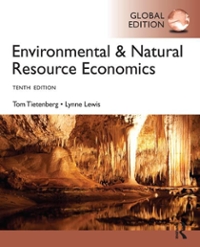Question
1. Each month Larrypurchases household utilities. His preferences over gallons of heating oil (x) and units of other utilities (y) can be represented by the
1. Each month Larrypurchases household utilities. His preferences over gallons of heating oil (x) and units of other utilities (y) can be represented by the utility function: U(x,y) = lnx + lny. Suppose that the market price of heating oil is $4 per gallon, the price of a unit of other utilities is $1 and that Larry has$320 to spend per month on his utilities.
a) Derive Larry's demand functions for heating oil and other utilities.
b) Illustrate Larry's budget set. Due to the high price of heating oil the federal governmentgives an in-kind transfer to Larryof 20 free gallons of heating oil per month at a cost of $80 to the government.
c) In your diagram for part (b) illustrate Larry's new budget set.
d) Using your demand functions find hisbest bundle on his new (post-transfer) budget line.
e) We can value the in-kind transfer by thinking of the dollar change in income that is equivalent in its effect to the in-kind transfer. What would be the value of the in-kind transfer of 20 gallons of heating oil?
Representative Mock dislikes government handouts and would much prefer to manipulate the market to make Larrybetter off. So Representative Mock proposes to get rid of the in-kind transfer of heating oil and in its place use a per-unit subsidy to lower the price of heating oil.
His first proposal is to set the subsidy per gallon of heating oil so that the Larry could continue to afford the same bundle, (50,200) that he chose when he received the in-kind transfer.
f) What would be the per-unit subsidy of the price of heating oil have so that Larry could just afford to purchase (50,200)at his income of $320?
g) Illustrate in your diagram the new budget line associated with thisper gallon subsidy.
i .Will Larrybuy more or less than 50 gallons of heating oil? Briefly explain.
ii.Will the cost to the government be more or less than the $80 that the government spent on the in-kind transfer? Briefly explain.
Redraw your budget setsfrom part (b) in a new diagram. Include in your diagram your budget line from part (c), the best bundle (50,200) and the indifference curve through this bundle.
His second proposal is to set the value of the subsidy so that Larryis no better off with the subsidy than he was with the in-kind transfer. In particular, he proposes to set the price of heating oil at $2.56 per gallon.
h) Using your demand functions from part (a) find Larry's best bundle at the new price of $2.56 per gallon. Verify that Larryis equally happy with this bundle as he was with the bundle (50,200).
i) In your new diagram illustrate the budget line associated with a priceof $2.56 per gallon of heating oil and indicate the best bundle from part (h).
j) What is the equivalent variation of this price change? What is the cost to the government?
2. In 2000 Ellis spends his snack dollars on chocolate chip cookies (x) and graham crackers (y). His preferences over chocolate chip cookies (x) and graham crackers (y) can be represented by the utility function U(x,y) = x+ 4lny.
a) If the price of a chocolate chip cookie is Px, the price of a graham cracker is Pyand he has $I to spend each week on snacks then find his (Marshallian) demand functions for chocolate chip cookies and graham crackers.
b) Suppose that Px= $1.50, Py= $1 and I = $9. Using your answer to (a) find his demands for chocolate chip cookies and graham crackers. Illustrate your answer in an indifference curve diagram. Include in your diagram an indifference curve through his best bundle. By 2010 the price of a chocolate chip cookie has risen to $4 and the price of a graham cracker has risen to $2.
c) Which good has become relatively cheaper?
d) If Ellis would like to continue to purchase the bundle of chocolate chip cookies and graham crackers that he purchased in 2000 then how much money will he need in 2010?
e) What is the rate of inflation for snack expenditures between 2000 and 2010? Suppose that in 2010 Ellis's income is adjusted for the rate of inflation calculated in part (e).
f) Will Ellis purchase the same bundle of goods in 2010 that he purchased in 2000? Briefly explain your answer. You must refer to his MRS in order to receive full credit.
g)Is Ellis better or worse off in 2010 if his income is adjusted for the rate of inflation?
h) An ideal cost of living adjustment would adjust income so that an individual no better nor worse off after prices change. What problem do you have to solve to find the ideal cost of living adjustment for Ellis? What are the first-order conditions for that problem?
Step by Step Solution
There are 3 Steps involved in it
Step: 1

Get Instant Access to Expert-Tailored Solutions
See step-by-step solutions with expert insights and AI powered tools for academic success
Step: 2

Step: 3

Ace Your Homework with AI
Get the answers you need in no time with our AI-driven, step-by-step assistance
Get Started


